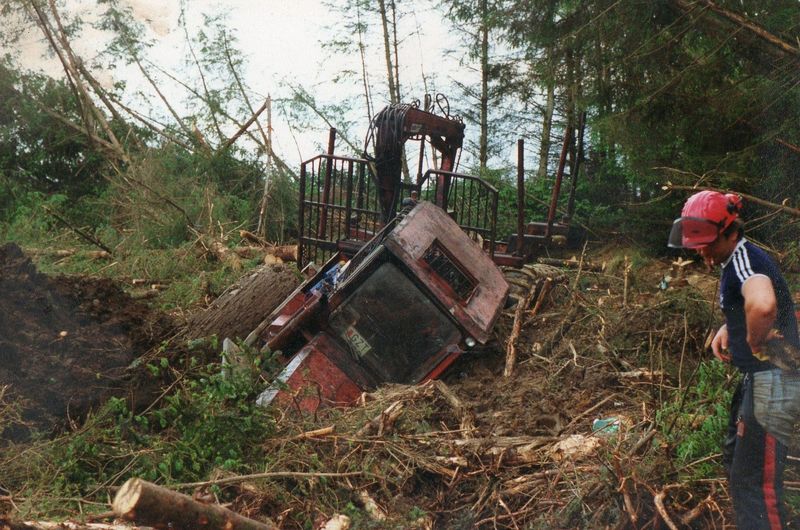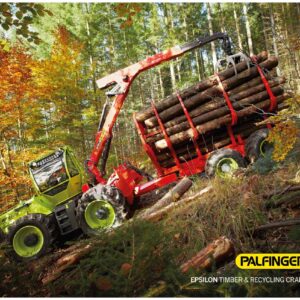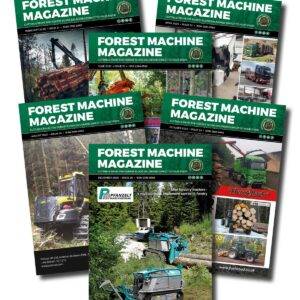The life of a forest machine operator can certainly bog you down in more ways than one. Here is a recollection of some of my own mishaps from my time as an operator.
It doesn’t matter how good an operator you are, everyone f***s up eventually at one time or another and any operator that tells you differently is a liar!
I myself have experienced that sinking feeling more than once and have been both a giver and receiver when it comes to being bogged. As a rule, harvester operators are at less of a risk of getting bogged than forwarder operators as they are generally running on their own freshly built brash mat and have less ground pressure. A well-constructed brash mat not only protects the ground from soil compaction and rutting but also significantly improves the forwarder’s production.
The soil is a great deal softer in the west of the UK due to the peaty ground conditions, so harvesters and forwarders are usually fitted with band tracks to the front and rear. Most manufacturers offer a selection of band tracks designed to work in specific terrains; for example, I worked on a peat bog many years ago operating a Valmet 860 which was fitted with extra wide Clark flotation tracks on the rear, and the range of travel provided by these tracks was unbelievable. There were large areas of pine with poor brash mats where the trees were floating on the bog. When loading, the first couple of feet on the main lift ram saw the timber and grapple remain in place as the forwarder wallowed into the ground on one side before starting to lift the timber.
It is not a nice sensation travelling across this type ground and it can be described as like being out in a boat on a stormy day. I found the best way to load was to set the potentiometer to a crawling speed. This way, the forwarder was constantly moving and never got a chance to settle. When I eventually got home in the evening I would swear that the floor was moving and many a time I was accused of stopping off at the pub as I was swaying about too much.
Having done this job for over 40 years I have had a few episodes over the years, which I can now look back on and laugh about. I thought I would share some of these adventures with you.
Kockums 850 – Early 1980’s – North Wales.
I was working on a contract for the Forestry Commission (FC) in North Wales on a peat bog near Pant Glas in Gwynedd. With hindsight, this work should have taken place using a Bruunett 678 or similar sized forwarder but as a young inexperienced contractor I had been wrongly advised by an unscrupulous salesperson that the Kockums 850 was perfect for the job.
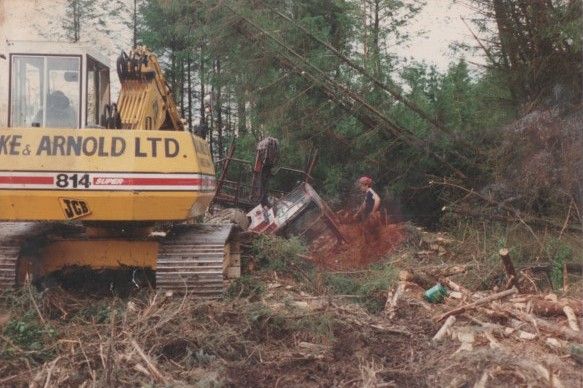

From day one, I had a funny feeling that the salesperson had not been completely honest with me. The Kockums was similar to an unruly dog and would dive into any wet muddy hole it could find, and that particular forwarder seemed to be happiest when it was almost out of sight underground and completely lathered in mud. I gained more experience in de-bogging techniques during the first six months with the Kockums than most professional recovery companies do in a lifetime. Being bogged was a regular occurrence on this site, but one day my Kockums excelled itself when, while bogged, it decided to split the main oil hose to the oil spinner (instead of a filter), which I didn’t realise until I began to hear a very unhealthy knocking noise.
Removing the engine in the middle of a midge and snake infested bog and getting it to roadside proved to be quite an operation, achieved by hand winching it once we strapped it to the belly pan. We also had to lay boards underneath the belly pan to clear tree stumps and prevent it from getting bogged.


After the engine was repaired and back in the forwarder, we had to get an excavator to help with de-bogging. Having been in the bog for almost two weeks, the suction had a good hold; therefore, it was necessary to dig around it and lay tree stumps upside down to ramp it back up to ground level. Using the excavator boom and a five-tonne Tirfor winch with a snatch block doubling the pull, we were back up and running and ready to face the next disaster.
Brunett 678 – 1995 – Ayrshire
This was my first foray into the dark side; I was operating a Brunett 678 harvester with a reversed cab and the crane mounted on the rear bunk, fitted with an FMG 840 harvesting head. The conversion had been completed by the UK FMG authorised dealer Emmex Forestry. I was working in first thinnings (single rows with selective thinnings between the rows) just outside Dalmellington on the New Cumnock road, and at this point I was relatively new to operating a harvester.
The site was wet and soft and I managed to get myself well and truly bogged half way down a rack. The blame was equally proportioned between my inexperience and the very soft ground conditions. I was working for Arthur Tulloch and back then the training consisted of “there’s the machine, here are the keys, the sizes are in the computer, and I’m sure you will figure it out as you go along”. I phoned Arthur to find out how to proceed, and let’s just say he wasn’t best pleased with me. He arranged for the FC at Heathhall in Dumfries to deliver us a Lokomo they had available for hire. It arrived later that day and Arthur drove down the rack, attached the Brunett to the Lokomo with a chain, and, after five minutes of trying to pull me out, duly bogged the Lokomo.He used the crane to try and fill in under the Lokomo’s wheels with brash. After a few minutes I thought we had discovered a new source of oil which was spraying all over my back window, but eventually I realised from the screaming obscenities and flailing arms inside the Lokomo that Arthur had dislodged some hydraulic fittings. I thought it might be a good idea to stay where I was until Arthur recovered his normal demeanour. After smoking several cigarettes in rapid succession, Arthur exited the cabin of the Lokomo and I said, “I guess I’m not the only idiot to get bogged then,” which broke the tension.


With both vehicles completely incapacitated, we contacted the FC to send the crawler with the Boughton recovery winch. Valmet 860 – 2000 – Dumfries and Galloway
Having recently started working as a forwarder operator for the Dick Brothers ltd in 2000, I acquired a spanking new Valmet 860 and began a job on a flat, wet site not far from the village of Laurieston which was mixed with Pine and Sitka Spruce and was extremely soft. I was working alongside a JD 1270 harvester and had been stuck just the once. There was a huge amount of hag that needed moving around to keep the forwarder afloat as some areas were almost a mile extraction distance across a swamp to roadside. The harvester was way ahead of me. It was summer and, as the timber was drying out rapidly, Davy Dick decided to move the harvester out to another site on a shorter haul where the forwarder was chasing the harvester. This sounded like a great plan as it would take the pressure off and allow me to catch up with the timber on the ground. All went swimmingly for the first three weeks but then one horrible wet and windy night I strayed off the brash mat slightly and within seconds was sat at a very precarious angle. Despite my efforts to straighten the forwarder, it ended up completely bogged. I was about half a mile from roadside on a pissing wet night with no torch or waterproofs, faced with a mammoth trek across a swamp. I was frozen and wet through by the time I eventually made it to the van, at which point I decided to make my way home for a hot bath and a warm meal and then assess the situation in the morning before reporting back to base. Although the weather the following morning was much brighter, my day got quite a bit gloomier when I saw the forwarder well and truly bogged. It was not going to come out on its own and I would definitely need another machine to pull me out. Mobile phone service was in its infancy so I spent an age walking round the site waving my phone in the air until I found some signal. I was now in a major dilemma; do I phone Davy and face the music, or do I run away and join the merchant navy never to be heard of again? I decided to face the music and in all fairness Davy was extremely calm and relaxed about the situation – he arranged for another forwarder to come over from Hawick, about three hours away, as soon as possible. The following day a red and black cab Valmet 860 arrived on the low loader followed by Joe, the operator. I met him at roadside and put shackles and the towing chain on his forwarder and set off to de-bog mine. I was in the cab with Joe giving him directions across the main extraction routes.
I was facing the rear of the forwarder but kept turning round every now and again to make sure we were on the right track. I was chatting away to Joe when he started uttering obscenities, leaving me wondering what I had done to upset him.
While facing forward, Joe had decided it would be a good idea to take a shortcut across a ride covered in rushes; his forwarder was now bogged even worse than mine. Joe’s suggestion was to phone Davy and get another machine on site but I thought that phone call would have probably resulted in us both looking for a new job. After desperately phoning around I found that Richard Scott (Scotty) was working about five miles away in the same forest. Scotty agreed to save the day and came along with his JD1410, pulling me out – I then in turn pulled Joe out. My explanation to Davy was a lot less stressful now that both forwarders were above ground and extracting wood.
Ponsse Buffalo – 2011 – Aberfoyle
This incident is not about being bogged as such and is more about being recovered but let me tell you that clean underwear was needed on more than one occasion. I was extracting on a big clear fell, approximately 20,000m³ in total, and was following a Tigercat LH 845C.There was a bit of everything thrown into the mix on this job – very steep areas, rock ledges, severe drops, bottomless peat bogs, and a haul of up to 2,000m to the back of the job. The site contained a maze of extraction routes for the steeper areas as the forwarder was unable to reverse up them, meaning the operator had to find a winding track to the top before dropping down the steeper drifts. There was one area I had been eyeing up for a few days and building up the courage to extract; it was extremely steep with a banked 90° right hand bend at the bottom to link back up to the extraction track. To the side of the track, the ground fell away to an almost vertical drop of 35/40 metres. I decided that today was the day and got myself positioned at the top. My plan was to get three quarters loaded and top up once I had negotiated the corner at the bottom.
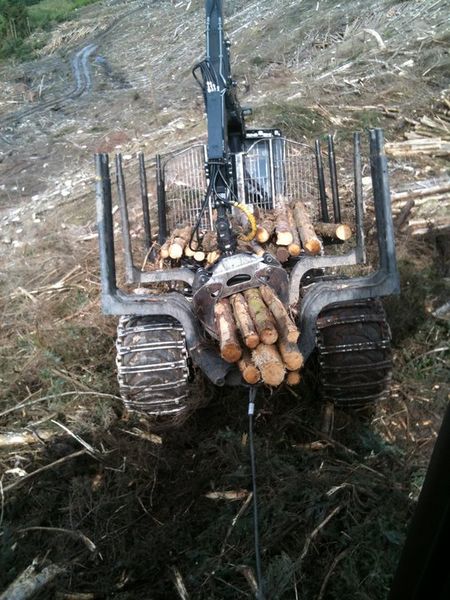

Despite a bit of forwarder skiing on the way down my first load went like clockwork, and I reckoned on there being about 120 tonnes there altogether so off I went for my second load. I had pushed some of the brash in front of me on the steepest section with my first load but thought no more of it. However, during my descent I ran into a big tree stump still hidden by brash and, as my forwarder bellied out on it, it took off like a rocket and I had no control over either the forwarder or my bowels. The forwarder was off the brash mat now and I was careering over the stacked timber at a high velocity, heading for a bloody big drop which would have seen the demise of my Ponsse Buffalo and probably me. As I overshot the severe turn my forwarder started to slow on the brakes and I managed to stop it about three metres short of the drop. After getting myself together, my hands stopped shaking enough to phone the harvester operator for assistance fortunately, he was only about 20 minutes away. The driver wasn’t sure whether he would be able to pull me as it was very steep but he had the advantage of hanging his boom and harvesting head in front as a counter balance. He started to pull me and I was moving back up the slope slowly when he decided to slew round to face me. Our wire strop wasn’t that long and, as he slew round, I saw the Tigercat start to lift on the front tracks; for a split second, I thought it would end up on the rear bunk with the dipper boom and LogMax head in the cab with me. Luckily, the operator realised this as well and continued his slew all the way round and back up the hill. He had only just managed to catch it before it tipped onto me. He continued to gently pull me until I managed to get back on the brash mat; once I was successfully at the bottom, he grabbed the wood off the steepest part and threw it down to the bottom of the slope so I wouldn’t have to try that again.
Ponsse Ergo – 2013 – Aberfoyle
This time I was not the villain, which makes a change. There is some background to this incident; this operator had not long started with the company I was working for and in his mind he was the “numero uno” harvesting operator in the whole universe and beyond.He was so far up his own arse it was unbelievable: yes he could cut wood, but his presentation of timber and brash mats were extremely poor. His harvester was relatively new but he had experienced a lot more downtime than any other harvesting operators I have followed and, given the amount of hydraulic oil he went through, I surmised that he could have done with his own supply from the North Sea to be able to keep the harvester working. My production and income were greatly reduced due to his incompetence.
I like to think I can get on with most people but on this occasion communications between us broke down altogether. It wasn’t just me as he had antagonised many other people to the point that his phone calls were ignored if he required help or assistance.
I was arriving at roadside with my first forwarder load on a Monday morning when our chainsaw operator approached me. “Don’t shoot me, I’m just the messenger,” he said, explaining that the harvester had got stuck on Saturday night and would need pulling out.
I prepared for de-bogging – unloading, picking up strops, etc. – and headed up to where he was stuck. It was about 1,500m from the forest road, and he had walked out after getting stuck in pitch black darkness with no torch. The site was steep and wet, so it must have taken him quite a while to get to his vehicle.
The driver had got stuck in an area of windblown timber which had been down for some time. The timber was still solid; some had blown down and the rest had snapped off part way up. Most of the branches and tops were dead but the timber remained solid. The operator was harvesting downhill to a stream, roughly 100m down a 20° slope. Many of the trees had blown over with the roots still attached but some of the others had snapped off. They were reasonably sized trees and the ones snapped off had to be cut off a bit higher above ground than normal due to the gritty conditions. He had finished harvesting the drift and was reversing back up to the extraction track when he got stuck.
Firstly, I decided to go and get a forwarder load of fresh brash so I could get a bit more grip on the greasy surface. Unfortunately, he was really hanked on something underneath and I couldn’t budge him, I got another load of brash to try and fill in under his wheels to see if we could get the harvester to climb up and clear the obstacle. However, after trying for about three hours I still couldn’t budge him. The only solution I could see to get him out was to go down the harvested row next to him, move some of the produce and blown stumps, and jump over to his row and pull him downhill.
What he said next was unbelievable; he told me there was no need for that as he could still move forwards under his own steam! I couldn’t believe he had wasted a whole morning and walked all the way out when all he had to do was move some wood and a couple of stumps to jump a row and drive out. Writing this today, I still find myself shaking my head at his utter stupidity.
My final incident happened a few weeks prior to leaving forwarding to prepare for the magazine launch.
I was not far off finishing a large clearfell near Callander in the Trossachs when I got a call to say that a low loader was on its way to pick me up as a harvester was stuck a few miles up the other side of the valley from where I was working. Luckily I was in the process of unloading so it didn’t take long to gather up my diesel bowser and other bits and pieces. Fortunately it was Paul Millar with the low loader and he had rubber mats on his trailer which meant I could leave my band tracks on, a huge time saver.
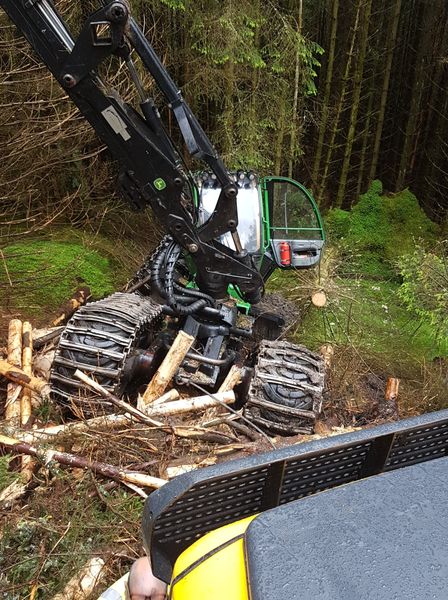

It was quite a severe climb up to where the harvesting was being done but it was summer and the forest roads were in reasonably good condition. The harvester was stuck about 300m down a fairly steep drift with standing timber either side. The operator had cut about 400m down the rack, and then went roughly 200m across, before taking another drift back up. His plan was to harvest left to right between the two tracks up and down.
I set off down the forest and decided to go down head first as it would allow me to angle the cab out of the way if I needed to use my crane. A few feet down I realised I was in bother, although the drift ran downhill it also had a side slope all the way down with a gulley and a stream at the bottom to my left, and the brash mat was narrower than my forwarder. My options were either to drive through all the stacked produce onmy right to keep on the brash mat or to move the brash mat over with the crane. I decided on option two as picking up scattered wood that I had driven through held no appeal whatsoever.
It took me almost two hours to sort out the brash mat and to reach the JD 1270E harvester which was half a metre narrower than the Buffalo. I was pretty astonished by what I saw. There was a small clearing to the side and I was pretty sure he had reversed off the brash mat to turn around, although it was on a hill the ground was really soft and peaty. I asked him what he had been trying to do and he said he wanted to reverse down to the bottom to start his cross drifts but found “IT WAS A BIT NARROW AND DODGY” so he thought it best to reverse off the brash mat into a small clearing of windblow to turn around allowing him to drive head first. Anyone with half a gram of common sense knew this plan was doomed from the outset, if he had driven up to the road then turned around it would have been a completely different outcome. I must admit to being pretty angry by this point as his produce stacking skills was on an even par with his brash mat building.
I pulled him out without any further incident and it was decided that I would continue there until I finished up just in case. The next few weeks driving along brash mats that were better suited to a wheelbarrow and trying to pick up timber that looked like it had been dropped from the sky made me realise that I really had made the right decision to start a magazine.


Forest Machine Magazine‘s is a dedicated forestry news channel. It is written and edited by a forest professional with over 40 years hands on experience. We are dedicated to keeping you informed with all the latest news, views and reviews from our industry.
To support us you can subscribe to our bi-monthly magazine which is delivered to your door from only £30 per year.
Subscribe here
#homeoflogging #writtenbyloggersforloggers #loggingallovertheworld

